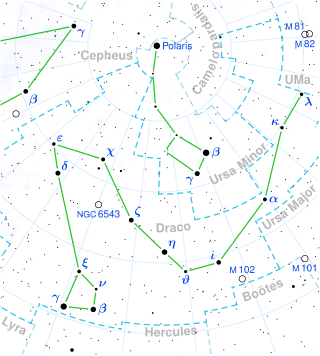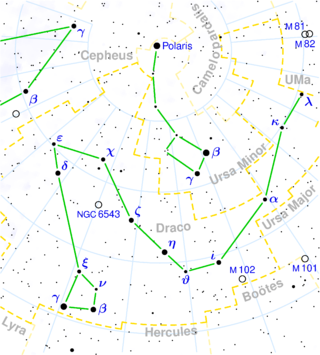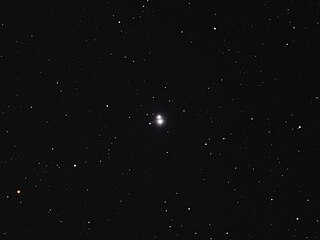Related Research Articles

Draco is a constellation in the far northern sky. Its name is Latin for dragon. It was one of the 48 constellations listed by the 2nd century astronomer Ptolemy, and remains one of the 88 modern constellations today. The north pole of the ecliptic is in Draco. Draco is circumpolar from northern latitudes. There it is never setting and therefore can be seen all year.

Hercules is a constellation named after Hercules, the Roman mythological hero adapted from the Greek hero Heracles. Hercules was one of the 48 constellations listed by the second-century astronomer Ptolemy, and it remains one of the 88 modern constellations today. It is the fifth-largest of the modern constellations and is the largest of the 50 which have no stars brighter than apparent magnitude +2.5.
Draco is the Greco-Latin word for serpent, or dragon.

Mu Draconis is a multiple star system near the head of the constellation of Draco. With a combined magnitude of 4.92, it is visible to the naked eye. Based on parallax estimates by the Hipparcos spacecraft, it is located approximately 89 light-years from the Sun.

Gamma Draconis, formally named Eltanin, is a star in the northern constellation of Draco. Contrary to its gamma-designation, it is the brightest star in Draco at magnitude 2.2, outshining Beta Draconis by nearly half a magnitude and Alpha Draconis by over a magnitude.

Beta Draconis, a name Latinized from β Draconis, is a binary star system and the third-brightest star in the northern circumpolar constellation of Draco. The two components are designated Beta Draconis A and B respectively. With a combined apparent visual magnitude of 2.79, it is bright enough to be easily seen with the naked eye. Based upon parallax measurements from the Hipparcos astrometry satellite, it lies at a distance of about 380 light-years from the Sun. The system is drifting closer with a radial velocity of −21 km/s.

Beta Serpentis, Latinized from β Serpentis, is a binary star system in the constellation Serpens, in its head. It is visible to the naked eye with a combined apparent visual magnitude of +3.65. Based upon an annual parallax shift of 21.03 mas as seen from Earth, it is located around 155 light years from the Sun. The system is a member of the Ursa Major Moving Group.

Delta Serpentis, Latinized from δ Serpentis, is a binary star system in the constellation Serpens, in its head. The light from the two stars in the system give a combined apparent magnitude of +3.80, which is bright enough to be visible to the naked eye. Based on parallax measurements, it is located at a distance of approximately 230 light years from the Sun. The system is moving closer with a radial velocity of ~42 km/s, and may come to within 115 light-years in 1.2 million years.
Gamma Serpentis is a star in the equatorial constellation Serpens, in the part of the constellation that represents the serpent's head. It has an apparent visual magnitude +3.85, which means it is visible to the naked eye. Based upon parallax measurements by the Hipparcos spacecraft, this star is approximately 36.7 light years from Earth.

Nu Draconis is a double star in the constellation Draco. The respective components are designated ν1 Draconis and ν2 Draconis. The second component is a spectroscopic binary star system.

Epsilon Draconis, Latinized from ε Draconis, is a fourth-magnitude star in the constellation Draco. This star along with Delta Draconis (Altais), Pi Draconis and Rho Draconis forms an asterism known as Al Tāis, meaning "the Goat".

Xi Draconis is a double or binary star in the northern circumpolar constellation of Draco. It has an apparent visual magnitude of 3.75. Based upon parallax measurements, it is located at a distance of 112.5 light-years from the Sun. At this distance, the apparent magnitude is diminished by 0.03 from extinction caused by intervening gas and dust.

Lambda Draconis, also named Giausar, is a solitary, orange-red star in the northern circumpolar constellation of Draco. It is visible to the naked eye with an apparent visual magnitude of +3.85. Based upon an annual parallax shift of 9.79 mas as seen from the Earth, the star is located around 333 light years from the Sun.

Gamma Herculis, Latinized from γ Herculis, is a magnitude 3.74 binary star system in the northern constellation of Hercules.

Psi¹ Draconis, also designated 31 Draconis, is a triple star system in the northern constellation of Draco. The system is fairly close, and is located about 75 light-years from the Sun, based on its parallax.

42 Draconis, formally named Fafnir, is a 5th magnitude K-type giant star located approximately 315 light years away in the constellation of Draco. As of 2009, an extrasolar planet is thought to be orbiting the star.

The Skalnaté Pleso Atlas of the Heavens is a set of 16 celestial charts covering the entire sky. It is named after the Skalnaté Pleso Observatory in Slovakia where it was produced. The first versions were published by the Czechoslovak Astronomical Society in 1948; later that year, Sky Publishing Corporation acquired the copyright and began publication in the United States. The charts were hand-drawn by Antonín Bečvář.

Theta Draconis, a name Latinized from θ Draconis, is a binary star system in the northern circumpolar constellation of Draco. It is faintly visible to the naked eye at night with an apparent visual magnitude of 4.12. Parallax measurements place it at an estimated distance of 68.6 light-years from the Sun, and it is drifting closer with a radial velocity of −8 km/s. It has a relatively high proper motion, traversing the celestial sphere at the rate of 0.464″ per year. O. J. Eggen included this star as a member of the NGC 1901 supercluster based on its space motion.
References
- Allen, R. H. (1899). Star-names and Their Meanings. New York: G. E. Stechart.
- Paul Kunitzsch (1959). Arabische Sternnamen in Europa, von Paul Kunitzsch. O. Harrassowitz.
- Kunitzsch, P.; Smart T. (2006). A Dictionary of Modern Star Names: A Short Guide to 254 Star Names and Their Derivations. Cambridge (USA): Sky Publishing Corporation.